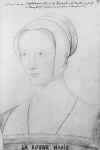Mary TUDOR (Queen of France and Duchess of Suffolk) (original) (raw)
**Mary TUDOR (Queen of France and D. of Suffolk)
La volent� De Dieu me suffit (The will of God is sufficient for me)
Born: 18 Mar 1496, Richmond Palace, England
Died: 25 Jun 1533, Westhorpe, Suffolk, England
Father: [HENRY VII TUDOR (King of England)](../TUDOR.htm#HENRY VII TUDOR %28King of England%29)
Mother: [Elizabeth PLANTAGENET (Queen of England)](../PLANTAGENET3.htm#Elizabeth PLANTAGENET %28Queen of England%29)
Married 1: LOUIS XII VALOIS (King of France) 9 Oct 1514, Abbeville
Married 2: [Charles BRANDON (1� D. Suffolk)](../BRANDON.htm#Charles BRANDON %281� D. Suffolk%29) 3 Mar 1515, Paris, France
Children:
1. Henry BRANDON (b. 11 Mar 1515/6 � d. 1522)
2. [Henry BRANDON (1� E. Lincoln)](../BRANDON.htm#Henry BRANDON %281� E. Lincoln%29)
3. [Frances BRANDON (D. Suffolk)](../BRANDON.htm#Frances BRANDON %28D. Suffolk%29)
4. [Eleanor](../BRANDON.htm#Eleonor BRANDON %28C. Cumberland%29) [BRANDON (C. Cumberland)](../BRANDON.htm#Eleonor BRANDON %28C. Cumberland%29)
A sketch of Mary Rose Tudor probably from 1514-1515
when she was Queen of France
Ashmolean Museum, Oxford
Princess Mary Rose Tudor was born to Henry VII and Elizabeth of York on Mar 18, 1496 and was the youngest child of the King and Queen to live past childhood. As she grew, Mary became a beautiful lady and was widely considered to be one of the most attractive women in Europe at the time.
Mary was betrothed to Carlos (the future Holy Roman Emperor), who, through his mother, was a nephew of Catalina De Aragon, with a marriage planned for May 1514. After diplomatic delays and secret dealings between Spain, the Holy Roman Empire and France, Henry VIII(Mary's brother) canceled the betrothal. Mary was apparently please with this, since she probably had no desire to marry a boy four years younger.
Unfortunately, Henry's choice for a replacement was 34 years older than she-Louis XII, King of France, described as "feeble and pocky" and not a very pleasing prospect for a young, healthy and beautiful Princess. The King was a widower with no heir, and Henry was more than ready to supply his sister as a way of making truce with a continental power.
Mary had enjoyed unprecedented freedom at Henry VIII's court. Just fourteen when her father died, she had spent the next five years virtually unchaperoned in his hectic court, her brother openly encouraging her participation in every event. She shared her brother Henry's exuberance for spectacle and was the star of his court. Like him, she loved dancing, masques, and parties; they were also close emotionally. So when Henry told her that she would marry the widowed King of France, a man in his fifties with gout and a pock-marked face, she poured out her heart. Mary refused to wed the French King, weeping and sulking, and demanding to be allowed to marry Carlos. Of course, her brother refused. Finally she would do her duty as a Princess, since royal princesses were commonly regarded as a bartered commodity. But she told Henry when the marriage was over, she wanted to choose her next spouse - and choose him for love alone. It was an extraordinary demand for any woman of that time but Henry VIII loved his sister and he agreed. Why? Partly because he loved her but also because he wanted her to leave for France peacefully and willingly; and also, perhaps more troubling, because she had confessed her secret love to him - it was his best friend, Charles Brandon.
Brandon was the Duke of Suffolk, but was not royal; the title was granted because of his father's loyalty and service atBosworth field. But Mary wanted to wed him, even though such a match would have been considered her marrying beneath her. In turn, Charles was attracted to the princess, and was available, with two annulled marriages and a broken precontract.
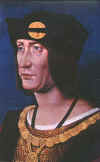 Louis XII of France Louis XII of France 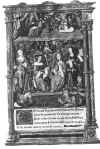 The marriage of Mary and Louis XII of France at Abbeville in 1514. Series of drawings by Pierre Gringoire, an eyewitness British Library The marriage of Mary and Louis XII of France at Abbeville in 1514. Series of drawings by Pierre Gringoire, an eyewitness British Library 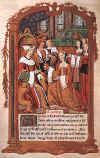 Mary and Louis XII of France British Library Mary and Louis XII of France British Library |
Mary first took part in a proxy marriage at Greenwich Palace on 13 Aug 1514, with the Duc De Longuevillestanding in for Louis (he lay down on a bed with Mary and touched her body with his naked leg - the marriage was declared consummated). Maryenjoyed herself at her wedding festivities and its attendant celebrations. It would have been impossible to feel otherwise. She had a splendid trousseau, marvelous jewels sent over from France, and all the honors due to the Queen of France. All contemporary accounts remark on her great beauty - particularly her clear complexion and long red-gold hair, the Tudor trademark. Her husband was eager to see her, telling the English Ambassador that he had many gifts for his bride and expected a kiss for each one. Mary eventually traveled from Dover to Boulogne on 2 Oct, after waiting weeks for stormy weather to end. (She left in the midst of more storms since Henry VIII had grown bored waiting for them to end.) Upon her departure, she kissed her brother and reminded him of his promise about her future. Henry, eager to leave, committed her to God and her husband and left. There were fourteen ships in Mary's retinue but the weather was so terrible that only four reached port on time (the rest docked at various ports on the French coast.) Poor Mary, suffering from seasickness and constant rain, was carried ashore by one of her gentlemen, Sir Christopher Garnish. She journeyed from Montreuil to Abbeville and contemporary chroniclers recorded her outfit (they were much impressed with her beauty and charm): cloth of gold on crimson with tight sleeves in the English style and a hat of crimson silk which she wore cocked over one eye. Her husband met her at a carefully arranged 'accident' outside Abbeville and, on 9 Oct, they married in that city, followed by weeks of celebrations. Most of the English entourage the princess had brought with her to France were sent back, although a few, including the Boleyn sisters Anneand Mary, remained. Mary remained the complacent princess, biding her time. The marriage obviously put a strain on her aging new husband. The marriage lasted for eighty-two days. On 31 Dec 1514, Louis died quite abruptly. Despite his ill health, he had been quite active during his marriage (a factor which may have contributed to his demise; he boasted that on their wedding night, he had 'crossed the river' three times). BEF his death, he was visited by the Duke of Suffolk on a diplomatic trip and Charles wrote to Henry that his sister was discreet and dignified. This undoubtedly relieved both men; they had perhaps wondered how Mary would greet her true love. Mary, however, was aware of her position as Queen of France and, during her brief marriage, conducted herself with aplomb. |
|---|
The King of France's death changed her world considerably. Now a Queen dowager in a foreign country she had barely begun to settle in, she was suddenly pushed into strict seclusion for 40 days. This was French custom; after all, the widowed Queen might be pregnant and the child's paternity must be certain. Marywas not pregnant but she was sent to the Hotel De Cluny for her period of mourning, without even the comfort of her English attendants. The new King, Francois, had appointed several Frenchwomen to attend her and dismissed her women. May was undoubtedly terrified. She was closed off from the world, shut behind heavy black drapes, and once more a pawn for her brother. Would Henry arrange another marriage or would he keep his promise? Frantic, Mary wrote to him from Cluny in early Jan 1515, just two weeks after her husband's death; she begged him to contact Francois and have her sent home to England and reminded him: "Sir, I beseech your grace that you will keep all the promises that you promised me when I took my leave of you by the waterside. Sir, your grace knoweth well that I did marry for your pleasure at this time and now I trust you will suffer me to marry as me liketh for to do... wherefore I beseech your grace for to be a good lord and brother unto me" If Henry did not keep his promise, Mary said she would enter a nunnery and "never no man shall joy of me".
Mary also had to deal with visits from the new French King. He was twenty-one and knew the English-French alliance was breaking down. He did not want Mary wed by Henry to some Hapsburg prince. He suggested two of his own kinsmen as husbands and then hinted that Henry was trying to marry her to Charles of Castile again. Alone, and in her fragile state, Mary was terribly frightened;Francois's words touched on her greatest fears. She eventually confessed her love for Suffolk to Francois. Surprisingly, she found him sympathetic and kind. He promised to help secure her future happiness, a promise which Mary found generous and Francois found opportunistic. For, by this time, he knew the** Duke of Suffolk** was on his way to France to bargain for Mary's return, specifically the return of her jewels, plate, and dower rights. With the dowager Queen's confession, Francois had a powerful bargaining tool (and peace of mind; if Marywed her English Duke, she was no longer Henry's political pawn).
** Charles**had been sent to France by Henry, specifically promising to keep his relations with the widow on a formal basis. Henry had no reason to distrust him. ** Charles**was his creation, dependent on him for everything, and also ambitious. Why would he bite the hand that so generously fed him? So Suffolk departed on his most important mission ever; it was well-known that the matter would be complicated. The French would not want to surrender any property to Mary and she would naturally want her rightful share. Beyond that, perhaps Henry meant to keep his promise. After all, he knew his sister's feelings - and now he sent her true love to bring her home. But rattled by Francois's suggestions of a Hapsburg marriage, Mary was set on a course which nearly ruined her and Suffolk.
Suffolkarrived on 27 Jan; five days later, he met Francois at Senlis. Francoissummoned Suffolk to a private audience and bluntly dropped his bombshell - theDuke had come to marry the Dowager Queen, had he not? Poor Suffolk was taken aback and protested vehemently. Francois went on to share Mary's confession and reassure the Duke. He was their friend, Francois said, and he would write to the English King and explain all. Suffolk took no chances; he dashed off his own account of the interview to Wolsey and then went to see Mary. It was a most emotional reunion. She accused him of taking her to England only to have her married off again against her will. He protested but she would have none of it. She issued an ultimatum - either marry me now or never marry me at all. There would be no better time, she said, for he had jealous enemies on the Privy Council who would prevent it in England. She had her brother's explicit promise that she could follow her heart and Henry knew her greatest desire. What was the risk for him, anyway? She was a princess and Queen, very beautiful, and imperious. Why would any man deny her? Suffolk was understandably torn between his obedience to Henry and his desire for Mary.
In the small chapel of the Palais De Cluny, sometime in Feb 1515, Mary Tudor did the unimaginable for a princess, she married the man "she" chose.
The consequences were rapid and hardly comforting. Francois demanded** Suffolk**'s acquiescence in several disputes over Mary's dowry as payment for their 'secret'. Meanwhile, Wolseyand Henry wanted the Duke to be firm and reject all the French king's demands. Furthermore, news of the wedding was circulating throughout Paris and Mary suspected she might be pregnant. Suffolk knew he could no longer delay confession and wrote toWolsey, now Archbishop of York. He wanted to arrange a more public wedding ceremony since he knew their secret wedding could easily be invalidated (certainly he knew that better than most.) And he feared that the king's council was urging an annulment. Many didn't consider **Suffolk**a fit match for a princess and others wanted to promote pro-Hapsburg policy of which Mary's remarriage could play a part.
| Henry's reaction was not favorable. Brandon had written to Wolsey for support and he received a prompt reply but it hardly comforted him; the King could not believe his most trusted friend had betrayed him but, if it were true, the newlyweds had to pay a stiff penalty - literally. They must pay back Mary's marriage portion in annual installments of 4000 pds, leaving her just 6000 pds to live on. She must return all the plate and jewels she had taken to France as her dowry as well as the many gifts King Louis had given her.Beyond that, they must hasten to beg the King for forgiveness. Suffolk and Mary did just that, both blaming her for the hasty marriage. Suffolk wrote: "Sir, for the passion of God, let it not be in your heart against me, and rather than you should hold me in mistrust, strike off my head and let me not live". Mary knew her brother well so, along with her letter, she sent him the most sumptuous jewel Louis had given her - a diamond called the Mirror of Naples (which formed part of the French crown jewels). She assured her brother that she had not acted out of 'sensual appetite'; instead, she had been subject to 'consternation, fear and doubt' which made her force Suffolk's hand. ** Henry**did not reply. Francois eventually allowed her to keep some of Louis's gifts and, on 16 Apr, they set out for the French coast. Mary wrote to Henry again at Calais, telling him that she was now under his jurisdiction again (Calais was an English possession) and that she would not sail for England until he gave permission. She reminded him of 'the great and tender love' they had always shared and promised to remain in Calais if that is what he wished. |  |
|---|
It was not - Henry sent permission for them to cross the Channel in early May; they met** Henry** privately at the manor of Barking outside London. There is no record of that meeting, of course, and one must assume that Wolsey had perhaps exaggerated** Henry**'s displeasure since he wanted Suffolk's gratitude. Henry was willing enough to forgive his best friend and favorite sister - after she turned over all her jewels and plate from France and signed a contract to repay the 24000 pds spent on her first marriage in the annual installments of 4000 pds. It was obvious that Henry was not surprised by the marriage; he was mostly angry at Suffolk for breaking his word.
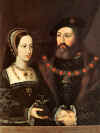 Mary and her second husband, Charles Brandon This particular copy is in the collection of the Earl of Yarborough Mary and her second husband, Charles Brandon This particular copy is in the collection of the Earl of Yarborough |
Suffolkand Mary were wed again at Greenwich Palace on 13 May with Henry and Catalina De Aragonin attendance. There was feasting and celebration but it was strictly a family affair and foreign Ambassadors wondered if they should congratulate the couple. After all, the situation was odd and there were some (mostly on the king's council) who disapproved of the match. But, for the most part, there were no hard feelings or grudges. Suffolk was a popular man, good-looking and charming, and few - even in Tudor England - could resist such a grand love story. After all, they had risked everything to be together. BEF long, the Suffolks were back in the king's good graces. They are recorded as extending all the great court celebrations of the next few years. Mary's pregnancy in France had been a false alarm but she did become pregnant a few months later. In fact, she was now pregnant along with her sister-in-law Catalina. Due to the Queen's history of miscarriages and stillbirths, few were hopeful of the outcome; but, on 18 Feb 1516, she gave birth to her only surviving child, a princess calledMary after her aunt. The new duchess of Suffolk, however, was more fortunate - on 11 Mar 1516, she gave birth to a healthy baby boy called Henry after the King. Henry and Wolsey stood as the child's godfathers. |
|---|
Mary and** Henry's older sister Margaret of Scotland visited that summer, bringing her six-month-old daughter, Lady Margaret Douglas. She had been in Scotland for thirteen years but her visit was pleasant enough. Henry had never tired of lecturing Margaret on morality (she had married theEarl of Angus** after James of Scotland's death at Flodden); this, of course, is laughable when one considers his own matrimonial career. But Margaret's visit was some ten years before Anne Boleyn entered Henry's life. In 1516, the King was just seven years into his reign, still handsome and bluff. Still, Margaret had little in common with her siblings after her years away; also, her first husband had been killed by the English at Flodden Field.
Mary Tudor was far closer to her foreign sister-in-law than to Margaret. After all, she and Catalina had spent their formative years together. When, in 1517,Catalina went on a pilgrimage to pray for a son, Mary accompanied her. Both Mary and Brandon understood the Queen's most heartfelt desire - to bear her husband a prince and successor - and were sympathetic supporters. There as a passing cloud in 1516 - Mary's revenues from France had fallen off and she was behind in payment of her debt - but the cloud passed quickly. In early summer 1517, they were at Richmond Palace again. Mary was once more pregnant and, on 16 Jul 1517, she went into labor on her way home. A daughter was born, called**Frances**; the Suffolks had another daughter, Eleanor, in 1519.
In 1518,Mary and Suffolk were at court again, attending the betrothal of the infant**Princess Mary** to the infant dauphin of France. And, of course, she attended the famous Field of the Cloth of Gold at Guines, near Calais in 1520. She was widely considered the most beautiful woman there; a French admiral commented, "Madame, you are the rose of Christendom. You should have stayed in France. We would have appreciated you". Mary was in her mid-twenties and, when Catalina De Aragon was pregnant or ill, acted as her brother's hostess.
Back in England, however, things began to change. In the new year of 1522, Mary first met Anne Boleyn. She knew Anne's older sister Mary quite well; Mary Boleyn had been one of her ladies-in-waiting when she wed Louis XII in France. She had also remained in France until dismissed by Francois. Anne wanted to join Queen Catalina's household as a lady-in-waiting, a much-sought-after position. It is likely that Mary repaid Mary Boleyn's service by helping Anne. Certainly she may have liked the girl; Anne had spent time at the French court and was fashionable and high-spirited, much like Mary.
Anneentered Catalina's service but was sent home in disgrace for three years. In just a matter of months, she had managed to attract the attention of Henry Percy, heir to the powerful Earl of Northumberland. The young couple entered into an understanding; however, Percy was under the guardianship of Wolsey. The king's most trusted advisor was understandably angry. Anne and Percy were brought to heel - there were better matches for him and she had overstepped her bounds. Anne was openly furious, so much that she was banished from court. However, she was allowed back in late 1525, around the time that Henry VIII was first beginning to contemplate his lack of heirs.
Catalina De Aragon had delivered the Princess Mary in 1516, when she was thirty-one years old. Since then, there were no other surviving children. In 1525, she was forty and it was obvious she would have no more children. Her husband was nervous; his dynasty was just forty years old. It would not survive with just one princess as heir. He knew the problem was not his fault - after all, in 1519, a mistress called Bessie Blount had born a son. In summer 1525, this child, called Henry Fitzroy, was made the Duke of Richmond and Somerset. (Suffolk was present at the ceremony.) Catalina was normally a patient, dignified wife but the lavish ceremony, involving all the important nobility, offended her. She argued with** Henry**, telling him it insulted her and their daughter Mary. Henry was unused to such criticism and responded by dismissing three of her favorite ladies. The Suffolks were not critical of their benefactor - after all, he had created his nephew the Earl of Lincoln at the same ceremony. Also, Mary's repayment of her debt was still in limbo.
She was also in failing health. She had suffered through the sweating sickness in 1518 and never completely recovered; it flared up occasionally. She may also have been exhibiting the first signs of the disease which eventually killed her (most believe it was cancer.) She was present at several court functions over the next few years (a summer 1526 party for European Ambassadors, for example) but came to court with less and less frequency. Her physical condition was deteriorating but she was also uncomfortable with her brother's course of action.
In 1527, Henry's infatuation with Anne Boleyn had begun. He was determined to annul his marriage to Catalina, arguing that it had never been legal in the first place. He asserted that Catalina and Arthur had consummated their marriage and, once again, his old friend Suffolk acted in the king's interest. He dug out some heretofore-lost memories that hinted at consummation. Meanwhile,Wolsey had lost** Henry's trust because of the many delays in the annulment and the King used Suffolk to openly attack him. At a public hearing on the case, Suffolk banged his fist on the table and shouted "It was never merry in England whilst we had cardinals among us". Of course, Suffolk would not have dared to attackWolsey** without** Henry**'s implicit support. It was the downfall of the Cardinal.
In 1531, Henry banished Catalina De Aragon from court. He and Anne were constantly together and he made no secret of his intention to marry her. The Suffolks were not happy about this but what could they do? They depended on Henry for everything. Mary made a cutting remark about Anne sometime in early 1532 and refused to accompany Henry and Anne on a state visit to France. Her husband warned Henry that Anne may have slept with Sir Thomas Wyatt. But that is all they dared. They were concerned about their own family.
The celebration of Frances's wedding to Henry Grey was held at the Suffolk home in London. It was Mary's last visit to the city. She was increasingly ill and also uncomfortable with her brother. His favor was no longer certain. He had married the pregnant Anne Boleyn in a secret ceremony. Suffolk was put in charge of the new Queen's coronation. Therefore, he was not with his wife when she passed away quietly at their home in Westhorpe on 26 Jun 1533. She was thirty-eight years old. Her death was not considered important news - most people were concerned with the impending birth of Anne Boleyn's child, destined to be Elizabeth I. Mary had seen her husband in early May but his duties kept him busy; it was a hurried visit and she simply wasted away in the next few weeks.
Her brother ordered requiem masses to be sung at Westminster Abbey but showed no other sign of mourning. He was, after all, in the midst of the Reformation. Charles Brandon did not attend the funeral but it was a marvelous affair. Mary Brandon, Baroness Mounteagle, and her sister Anne, Baroness Grey of Powys, pushed themselves to the front of the funeral cortege at the Abbey of St. Edmundsbury, just as the coffin was being lowered into the crypt, much to the consternation of their half-siblings. The coffin lay in state for a month at Westhorpe and was interred at the church of Bury St Edmunds on 22 Jul. The abbey church and her monument were destroyed during the dissolution of the monasteries. Her coffin was saved, however, and moved to a nearby church called St Mary. In 1784, it was moved yet again within that church. The movers ghoulishly opened the coffin - they found a good set of teeth and two feet of hair which was still red-gold. Souvenir hunters cut off pieces of the hair.
Mary's death was perhaps most mourned in Suffolk county where she had been a popular and respected figure. Her husband replaced her quickly enough - and, as was typical of Brandon, with aplomb. He decided to marry his son's betrothed. The girl was called Catherine Willoughby, his ward and the daughter of Lord Willoughby De Eresby and Catalina De Aragon's lady of honour Maria De Salinas. She was a baroness in her own right, heiress to 15000 ducats a year. She was also just fourteen-years-old, the same age as his youngest child. Brandon himself was almost fifty. But he needed money badly and she was very rich; he married her quite rapidly (exact date unknown). His and Mary's son, the eighteen-year-old Henry Brandon, Earl of Lincoln, would be betrothed elsewhere easily enough. But that was not to be - after his father's wedding, the young Earl died, probably of the Tudor scourge, tuberculosis.
Mary was always referred to as the Queen of France (commonly "The French Queen") and never as the Duchess of Suffolk. This was probably to remind her that she had married below her rank. But Mary essentially lived a quiet and happy remainder of her life.
